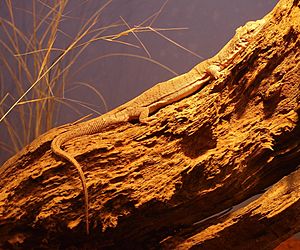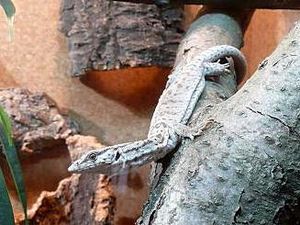Pygmy mulga monitor facts for kids
Quick facts for kids Pygmy mulga monitor |
|
|---|---|
 |
|
| Alice Springs Desert Park | |
| Conservation status | |
| Scientific classification | |
| Genus: |
Varanus
|
| Species: |
gilleni
|
| Synonyms | |
|
|
The pygmy mulga monitor (Varanus gilleni) is a type of lizard. It is also known as Gillen's monitor. This small lizard belongs to the family of Varanidae, which includes all monitor lizards.
Contents
About the Pygmy Mulga Monitor
Who Named This Lizard?
Two scientists, Arthur H. S. Lucas and Charles Frost, first described this species in 1895. They named it gilleni to honor Francis James Gillen. He was an anthropologist from Australia.
Where Does It Live?
The pygmy mulga monitor lives in the sandy plains of northwestern and central Australia. It likes areas with spinifex grass. You can often find it hiding under loose bark of desert she-oaks. It also lives in hollows of eucalyptus, mulga, and myall trees.
What Does It Look Like?
This monitor lizard is an arboreal animal, meaning it lives in trees. It has a special tail that can grip branches, called a prehensile tail. It grows to about 40 cm (16 inches) long. Its back is brown, and its sides are grey. Its nostrils are on the sides of its snout, halfway between its nose tip and eyes.
Pygmy mulga monitors usually weigh between 60 and 80 grams (2.1 to 2.8 ounces). Male lizards have small spines on the sides of their vent, which helps tell them apart from females.
Amazing Abilities
This lizard has incredible endurance. It can run for a long time without getting tired. Scientists even put them on treadmills! They found that these monitors could keep running at 1 kilometer per hour for "many minutes."
The pygmy mulga monitor is also very good at living in dry places. It loses water much slower than other Australian monitor lizards. This helps it survive in the desert.
What Does It Eat?
Even though it lives in trees, the pygmy mulga monitor often finds its food on the ground. It mainly eats spiders, grasshoppers, beetles, and other lizards. It especially likes geckos, such as Gehyra variegata and Heteronotia binoei. If a gecko is too big, the monitor might just attack its tail. Geckos can drop their tails to escape! The monitor also eats bird eggs, small mammals, and even tiny ants.
Life Cycle
Reproduction
Male pygmy mulga monitors sometimes have special fights. Unlike bigger monitors that stand on their back legs, these smaller lizards grapple with all four limbs. They roll around on the ground, belly to belly, trying to flip each other over. They might also bite.
Breeding usually happens between September and October. A female can lay up to 7 eggs in a burrow about 30 cm (12 inches) deep. She might then seal the burrow with sand. The eggs hatch after about three months.
Who Are Its Predators?
Birds of prey, snakes, and even larger monitor lizards hunt the pygmy mulga monitor. For example, Gould's monitors are known to prey on them.



